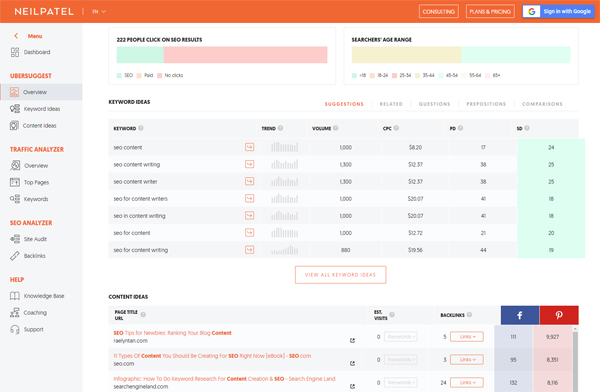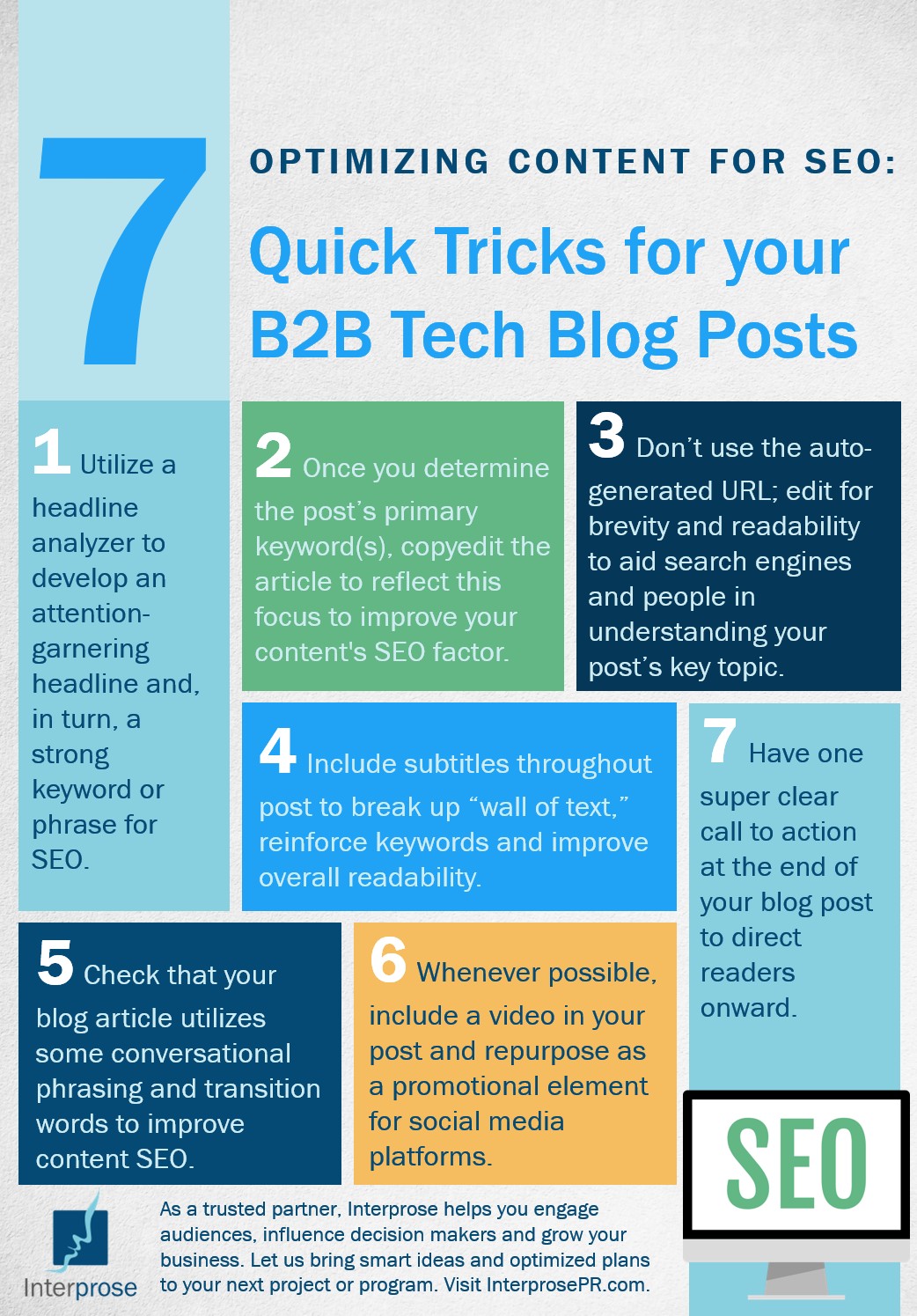Developing posts for your company’s blog from idea to publish takes a fair amount of planning, research, time, and effort. The last thing you want is your blog articles to go unnoticed because of poorly chosen keywords and editing decisions.
Incorporating these seven steps into your editorial process can help you optimize content for SEO (search engine optimization) easily and effectively.
We’ve been studying our own blog and those of our clients for the past six months in connection with Yoast SEO scoring to strengthen content for SEO and, therefore, our search engine placement results. What we found is that across the board most blog posts struggled in the following three areas:
- Keyword selection and usage
- URL length
- Formatting for readability and shareability
The good news is all of these can be handled in the editing and publishing phases so no need to bother Jack in Sales about the post he turned in last month.
So let’s get started making Jack’s post the best it can be.
Quick Trick #1: Utilize a headline analyzer to develop an attention-garnering headline and, in turn, a strong keyword or phrase for SEO.
The most crucial step is nailing the right key phrase. Keep in mind only 1 in 4 searchers will click to a second page of Google results so the more specific the term, the greater the chances of landing on that front page.
For instance, let’s take “cloud data services” which yields more than six million results! Not likely this post will get in the top ten. However, “cloud data services guidelines” yields only 89,600 results AND “cloud data guidelines 2020” only has five results. Hello front page of Google.

Example of Ubersuggest keyword research
But is your audience searching for guidelines? Or is another term used more often?
There are two ways to check.
- Review your Google Analytics “Conversion” section which shares search engine terms people used to be directed to your website.
- Search term tools like Ubersuggest and Answer The Public can help with research.
Just remember, your best bet is choosing keywords that are more specific.
So now let’s beef up Jack’s blog title for SEO by utilizing a headline analyzer. By having your key phrase in the title, the more likely this post will rank high in Google’s results.
We’ve made it a part of our Interprose Voice editorial process to test headlines through two analyzers and fiddle with our post titles for the strongest result. This has boosted traffic and only adds about ten minutes to our editing. The headline of this blog, for example, scored an overall 72 out of 100 on the Sharethrough Headline Analyzer.
Using this tool, I was able to take our phrase “cloud data guidelines 2020” and build the headline “Cloud Data Guidelines for 2020: Adhere to these now or face the financial consequences” which scored a 75 out of 100.
Quick Trick #2: Once you determine the post’s primary keyword(s), copyedit the article to reflect this focus to improve your content’s SEO factor.
So we have our strong headline, now we need to reinforce our key phrase throughout the article.
Know that Google understands synonyms and complementary words so the exact phrase does not need to be repeated. “Guidelines” can easily be termed best practices, codes, or markers.
Yoast SEO and consequently search engines like keyphrases to be:
- In the title
- In subheads throughout the piece. Subheads also help break up your text, making it easier for people to read
- Adding 3-4 times within the post copy itself. Two key spots would be the first and last paragraph of your post
- Used in your image ALT tags. These tags help engine crawlers understand an image since they can’t “see.” So for this post, I would add the ALT tag “cloud data guidelines 2020 server photo”
- Lastly, include in your post’s URL
Quick Trick #3: Don’t use the auto-generated URL; edit for brevity and readability to aid search engines and people in understanding your post’s key topic.
Most content management systems (CMS) auto-magically create a post’s URL based upon your headline when you first save the post. But these auto-generated URLs can get quite long making them not user-friendly. We recommend shortening a URL address yourself. Be sure to include or keep your key phrase for SEO.
For Jack’s post, I would shorten “Cloud Data Guidelines for 2020: Adhere to these now or face the financial consequences” to just “cloud-data-guidelines-2020” in the URL.
Bonus tip: Use hyphens (-) instead of underscores (_) in your URLs. Otherwise, search engines like Google will read it as one single word (so our “cloud_data_guidelines_2020” will be read as ‘clouddataguidelines2020’ by the search crawlers.
Quick Trick #4: Include subtitles throughout post to break up “wall of text,” reinforce keywords and improve overall readability.
Between identifying acronyms and lengthy engineering terminology, many B2B tech paragraphs can become quite lengthy and unwieldy. This is especially true when it comes to online, where the preference is for short sentences and brief paragraphs.
Consider that many readers will be viewing your post on mobile devices, so consider breaking up long sentences or paragraphs into bulleted lists and reinforcing key parts with a visual.
Quick Trick #5: Check that your blog article utilizes some conversational phrasing and transition words to improve content SEO.
One strong consideration for this step is the rise of voice searches and conversational phrasing helps. Voice assistants like Alexa scan for the phrase people are saying – “show me cloud data services near Austin” or “find cloud data help in Austin.” So if contemplating editing a simple phrase into something more verbose and technical, choose the former.
Yoast SEO scoring also helps with these matters and within the WordPress plugin they offer is a readability score and suggestions on how to improve such as too many long sentences or too much passive voice.
Realize this tool is used for all types of sites and so readability is set at a low education level. Much of B2B content scores poorly simply because of the technical terminology shared in a post.
Additionally, transition or signal words also improve post readability as they provide direction to readers. Yoast SEO likes at least 30% of the sentences to contain a transition word.
Favorite Transitional Words:
[row][column size=”1/2″ center=”no” class=””]AccordinglyAs a result
Therefore
Earlier
So far
Until now
First, second, etc.
In the second place
In contrast
Notwithstanding
For example
[/column] [column size=”1/2″ center=”no” class=””]Foundationally
Most importantly
In similar fashion
To clarify
Naturally
In conclusion
To conclude
Without doubt
In brief
To summarize
[/column][/row]
Quick Trick #6: Whenever possible, include a video in your post.
There are three strong reasons for making the effort:
- Majority of people will watch a video if within a blog post and that means more time on your page which also factors into your search engine ranking
- It is a visual component to help break up a “wall of text” and adding a different content type into your mix is always a good thing
- It can be used in other places, in particular, on social media to draw people to your post; it’s also a compelling element readers will share
This does not need to involve a lot of work. Finding an example or two on YouTube or Vimeo can be very useful.
Bonus tip: In late May, Yoast celebrated its 10th anniversary by sharing some great content related to SEO including a lot of videos.
Quick Trick #7: Have one super clear call to action at the end of your blog post to direct readers onward.
You have a strong post. It’s compelling, insightful and reaching people. Now what to you want them to do? Don’t miss this golden opportunity so be sure you have a call to action that is clear to other places on your website.
A call-to-action that feels part of your post itself works best and then does not come across like banner advertising, which often gets ignored.
Final Thoughts
Incorporate these seven strategies into your blog editorial process consistently for best results. At Interprose, we maintain a blog post checklist for our clients so we ensure these items do not get missed.
- Did proposed title go through headline analyzer? Did we verify a strong keyphrase for SEO?
- Copyediting and proofing done specific to SEO keyphase
- Auto-generated URL edited for brevity and readability
- Subtitles included? No long paragraphs?
- Conversational phrasing and transition words to improve content SEO included?
- Can we add a video to this post? Other unique visual element?
- Is there one super clear call to action at the end to direct readers to next steps?
SEO is an ever growing ocean for professional communicators to navigate. By taking small steps consistently and regularly, businesses are able to utilize SEO to optimize their content to grow leads and improve conversions.


